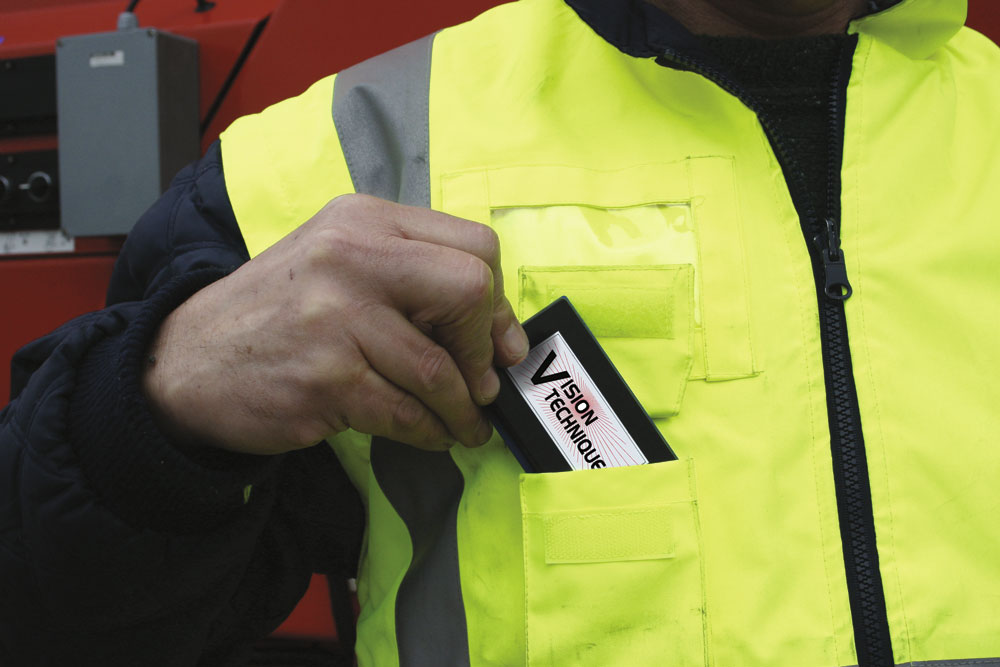Zone Safe

With health and safety high on the agenda in the quarrying industry, Vision Techniques have utilized RFID technology to immobilize potentially hazardous machinery, preventing unauthorized operation
These days health, safety and security are key issues for any responsible company in the UK. With legislation on the increase, it has become a major daily task to keep ahead of these issues in any industry.
Vision Techniques have been working in the health and safety arena for a number of years and were originally known for their high-tech CCTV rear-vision cameras and Ogden radar systems. As designers and manufacturers, however, they have kept pace with the technology available and are now able to offer any industry that operates vehicles, plant or machinery a comprehensive safety solution in the form of ‘Zone Safe’, a safety system which utilizes radio frequency identification (RFID).
Zone Safe can disable potentially hazardous machinery, preventing unauthorized operation and allowing access to authorized operators only. With its flexible modular design it can protect single or multiple control points for an unlimited number of operators and is easy to install. Offering discreet and reliable operation, the system uses proven technology to provide a safe and secure working zone for all types of equipment without compromising workflow.
According to Vision Techniques, Zone Safe applications are numerous including any vehicle that has an externally controlled, PTO–driven operation, such as waste trucks, recycling vehicles, bulk blowers etc, as well as any vehicle, machine or plant where operation or access must be restricted to authorized personnel, for example fork-lift trucks, excavators and processing machinery.
Transponders, which are worn by operators at all times, are ‘woken up’ when they enter an activation zone; this is controlled by a wake-up antenna (providing a flexible way to protect individual control points). Data from the transponder is then sent to a receiver/ decoder unit that determines operator authorization and activates the machinery if appropriate. A distribution box allows system activity to be easily monitored and provides a simple system installation point.
A standard system consists of: one receiver/decoder module; one distribution box; three wake-up antenna modules; and two Zone Safe transponders. Additional transponders for more operators and additional wake-up antenna modules for more activation zones can be added to the standard system as necessary.
The benefits of Zone Safe include:
- keyless control
- no codes required
- no moving parts
- easy to install and operate
- discreet, reliable operation
- safe zone transponders
- workflow-friendly system
- rugged
- weatherproof to IP65
- CE & E approved.
What is RFID?
RFID utilizes transponders, usually called tags, that have an antenna and an ASIC (application-specific integrated circuit) with memory. The history of RFID can be traced back to 'friend or foe' transponders, the remote transmitter/ receiver devices fitted to aircraft in World War II, through scientific work in the 1970s, to animal ID tags introduced in the US and UK in the 1980s.
Growth in the 1990s was primarily in two fields — access control (contact-less ID cards) and car security. Many car keys contain an RFID tag that is read by an antenna in the steering column and used to immobilize the vehicle.
The ‘chipping’ of goods has become one of the best-known applications of RFID. Others include: automatic road-toll collection; ski-lift passes; timing in races such as the London Marathon (using tags fitted into running shoes); EAS (electronic article surveillance — an anti-theft measure in shops); asset management; pallet tracking and labelling for airline baggage; and retail logistics and the supply chain.
How does an RFID system work?
RFID uses radio waves to communicate information from a tag to a reader via an antenna. The tag is essentially a small radio transmitter. Using the reader (an electronic device that communicates with the tag) and antenna it is possible to read the data stored on the tag. The data can consist of serial numbers, security and or product codes. When the reader has read the tag data the information is passed on to a host system.
There are generally three component parts to any RFID system:
The tag
Passive, active, read-only and read-write versions programmed with a unique identifier or programmed data from the host system.
The reader/decoder
Used to generate the RF signal, read the data and interface with the host system.
The antenna
The point at which the RF field is generated to read the tag; this is often remote to the main decoder.
Types of RFID tags
RFID tags can come in a wide variety of shapes and sizes, from as small as a pencil lead for animal tracking to credit card-sized for access-control applications, and in ‘smart label’ formats or even in the form of a wristband. Some of the plastic anti-theft tags found in retail outlets are a type of RFID tag.
RFID tags can be active or passive (ie, with or without a battery). Passive tags are powered by the electromagnetic field generated by the reader while communicating with the tag. An active tag is powered by a long-life lithium cell and can be activated by a transmitted RF field generated by the reader, or data can be transmitted at set timed intervals.
Vision Techniques (UK) Ltd, Phoenix House, Phoenix Park, Blakewater Road, Blackburn, Lancs BB1 5RW; tel: (01254) 679717; fax: (01254) 690919; email: info@vision-techniques.com


